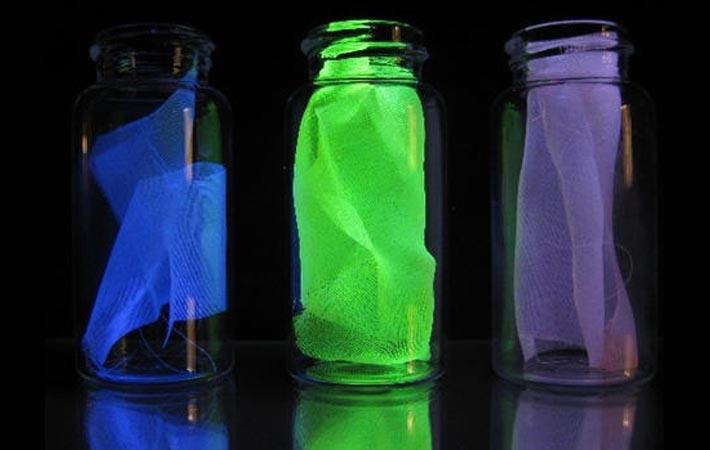Scientists in the US have developed a damage sensor which makes viewing the damage at a crucial part of a composite possible. The nanoscale damage-sensing probe known as a mechanophore has been made for the composite made of epoxy and silk. The team is now planning to explore how such probes could be used in other composites for different applications.
Scientists in the US have developed a damage sensor which makes viewing the damage at a crucial part of a composite possible. The nanoscale damage-sensing probe known as a mechanophore has been made for the composite made of epoxy and silk. The team is now planning to explore how such probes could be used in other composites for different applications.#
The probe is likely to speed up product testing and potentially reduce time and materials needed for development of many kinds of new composites. The research has been carried out by scientists at the National Institute of Standards and Technology. The results have been published in the journal Advance Materials Interfaces.
Scientists in the US have developed a damage sensor which makes viewing the damage at a crucial part of a composite possible. The nanoscale damage-sensing probe known as a mechanophore has been made for the composite made of epoxy and silk. The team is now planning to explore how such probes could be used in other composites for different applications.#
The development is in line with the need for new lightweight, energy-saving composites that will not crack or break even after prolonged exposure to environmental or structural stress. There has been persistent demand for fuel-efficient vehicles and high-performance sporting goods, weather-resistant bridges, and more efficient ways to make reliable cars and aircraft.
Scientists in the US have developed a damage sensor which makes viewing the damage at a crucial part of a composite possible. The nanoscale damage-sensing probe known as a mechanophore has been made for the composite made of epoxy and silk. The team is now planning to explore how such probes could be used in other composites for different applications.#
Diverse materials are used in designing composites. However, all composites have an interface where the components meet. The resilience of that interface is critical to a composite's ability to withstand damage. Interfaces that are thin but flexible are often favoured by designers and manufacturers, but it is very challenging to measure the interfacial properties in a composite.
Scientists in the US have developed a damage sensor which makes viewing the damage at a crucial part of a composite possible. The nanoscale damage-sensing probe known as a mechanophore has been made for the composite made of epoxy and silk. The team is now planning to explore how such probes could be used in other composites for different applications.#
The probe was created from a dye known as rhodamine spirolactam which changes from a dark state to a light state in reaction to an applied force. The molecule was attached to silk fibers contained inside an epoxy-based composite. As more and more force was applied to the composite, the stress and strain activated the RS, causing it to fluoresce when excited with a laser. Although the change was not visible to the naked eye, a red laser and a microscope built and designed by NIST were used to take photos inside the composite, showing even the most minute breaks and fissures to its interior, and revealing points where the fiber had fractured.
Scientists in the US have developed a damage sensor which makes viewing the damage at a crucial part of a composite possible. The nanoscale damage-sensing probe known as a mechanophore has been made for the composite made of epoxy and silk. The team is now planning to explore how such probes could be used in other composites for different applications.#
"There have long been ways to measure the macroscopic properties of composites. But for decades the challenge has been to determine what was happening inside, at the interface," said researcher Jeffrey Gilman, who led the team.
Scientists in the US have developed a damage sensor which makes viewing the damage at a crucial part of a composite possible. The nanoscale damage-sensing probe known as a mechanophore has been made for the composite made of epoxy and silk. The team is now planning to explore how such probes could be used in other composites for different applications.#
One option is optical imaging. However, conventional methods for optical imaging are only able to record images at scales as small as 200-400 nanometers. Some interfaces are only 10 to 100 nanometers in thickness, making such techniques somewhat ineffective for imaging the interphase in composites. By installing the RS probe at the interface, the researchers were able to "see" damage exclusively at the interface using optical microscopy.
Scientists in the US have developed a damage sensor which makes viewing the damage at a crucial part of a composite possible. The nanoscale damage-sensing probe known as a mechanophore has been made for the composite made of epoxy and silk. The team is now planning to explore how such probes could be used in other composites for different applications.#
"We now have a damage sensor to help optimise the composite for different applications. If you attempt a design change, you can figure out if the change you made improved the interface of a composite, or weakened it," Gilman said.
Scientists in the US have developed a damage sensor which makes viewing the damage at a crucial part of a composite possible. The nanoscale damage-sensing probe known as a mechanophore has been made for the composite made of epoxy and silk. The team is now planning to explore how such probes could be used in other composites for different applications.#
The team is now planning to expand their research to explore how such probes could be used in other kinds of composites as well. They also plan to use such sensors to enhance the capability of these composites to withstand extreme cold and heat. (SV)
Fibre2Fashion News Desk – India


